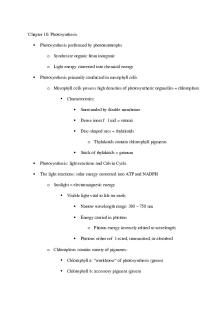Chapter 10: Photosynthesis PDF

| Title | Chapter 10: Photosynthesis |
|---|---|
| Course | Introductory Biology I |
| Institution | University of Delaware |
| Pages | 6 |
| File Size | 443.5 KB |
| File Type | |
| Total Downloads | 68 |
| Total Views | 134 |
Summary
chapter 10...
Description
Chapter 10: Photosynthesis
Photosynthesis ● Photosynthesis involves plants taking in water carbon dioxide, and light to make sugar and oxygen ● This is important because all living things need oxygen to survive Photosynthesis Harnesses Sunlight to Make Carbohydrates ● The overall reaction is ○ ● ●
CO2 + H2O + light energy →→→ (CH2O)n + O2
○ It is the “opposite” of cellular respiration Use of sunlight to manufacture carbohydrates Takes place in Chloroplasts ○ Thylakoids (flattened sacs) ○ Granum (stack of thylakoids) ○ Stroma (liquid matrix)
○
Photosynthetic Leaf and Chloroplasts ● Plants BREATHE ○ Stomata - carbon dioxide enters and oxygen exits leaf ○ Thylakoids (flattened sacs) ■ Location of “photo” reaction, where light energy is converted into chemical energy ■ Have little bumps - chlorophyll ○ Granum (stack of thylakoids) ○ Stroma (liquid matrix) ■ Location of “synthesis” reaction, where chemical energy is synthesized into sugar
Two Stages of Photosynthesis 1. Light Dependent Reactions - energy from sunlight is converted into chemical energy to replenish ATP and NADPH 2. Light Independent Reactions (Calvin Cycle) - excess energy is stored by building highenergy sugar molecules to be used when sunlight is not available
Photosynthesis:
Two Linked sets
of Reactions 1. The Light-Dependent reactions produce O2 from H2O ○ Water is split to form O2 (gas) ○ Its electrons are excited by light energy ○ High-energy electrons are transferred to the electron carrier NADP+, forming NADPH ○ ATP is also produced ○ Light Absorption ■ Pigments are molecules that absorb wavelengths of visible light. Pigments look colored because they REFLECT light enriched in the wavelengths that they do not absorb 1. Chlorophyll a ○ Dark green 2. Chlorophyll b ○ Light green 3. Carotenoid ○ Orange ■ Absorption of visible light by a chlorophyll molecule results in one of its electrons being elevated to a higher energy state
○
1. Two Photosystems (provide enough energy to pull electrons from water and then use them to reduce NADP+) ■ Photosystem II 1. Excited electrons travel to PS I ○ Water is oxidized → generates O2 and H+ ○ Releases energy in electron transport chain ○ Energy used to make H+ electrochemical gradient i. 2 H2O → 4 H+ + 4 e– + O2 ■ Photosystem I
○
1. Primary role to make NADPH ○ Addition of H+ to NADP contributes to H+ electrochemical gradient Electron Flow, H+ gradient proton accumulation ■
2. The Calvin Cycle - Light Independent Reactions produce sugar from CO2 ○ Clarify how ATP and NADPH are produced by light reactions allows cells to reduce CO2 to carbs ■ Electrons and ATP are used to reduce CO2 ■ CO2 is reduced and converted into organic substances 1. NADPH provides electrons and hydrogen 2. ATP provides additional energy ■ Carbon Fixation involves capturing CO2 molecules with the key enzyme Rubisco (RuBP carboxylase/oxygenase) 1. The reactions that produce sugar from carbon dioxide in the Calvin cycle are lightindependent ○ Requires massive input of energy ○ For every 6 CO2 incorporated, 18 ATP and 12 NADPH used 2. Discovery of Rubisco ○ The CO2-fixing enzyme is ribulose 1, 5-bisphosphate
○ ○
OVERVIEW⤵
carboxylase/oxygenase (rubisco) Rubisco is found in all photosynthetic organisms that use the Calvin cycle to fix carbon Thought to be the most abundant enzyme on Earth i. Provides the source of organic molecules for most of the worlds organisms 1. 100 billion tons of CO2 are converted into carbs each year 2. Represents 50% or more of the total protein in leaves...
Similar Free PDFs

Chapter 10- Photosynthesis
- 15 Pages

Chapter 10: Photosynthesis
- 6 Pages

Chapter 7 Photosynthesis
- 17 Pages

Chapter 5 Photosynthesis slides
- 28 Pages

Chapter 8 Photosynthesis
- 21 Pages

Chapter 8 Review Photosynthesis
- 4 Pages

Exam 2- chapter 9 photosynthesis
- 2 Pages

Photosynthesis Lab
- 8 Pages

Photosynthesis PAG
- 2 Pages

Chapter 10 quiz #10
- 3 Pages

Photosynthesis Notes
- 4 Pages

Photosynthesis-worksheet
- 4 Pages
Popular Institutions
- Tinajero National High School - Annex
- Politeknik Caltex Riau
- Yokohama City University
- SGT University
- University of Al-Qadisiyah
- Divine Word College of Vigan
- Techniek College Rotterdam
- Universidade de Santiago
- Universiti Teknologi MARA Cawangan Johor Kampus Pasir Gudang
- Poltekkes Kemenkes Yogyakarta
- Baguio City National High School
- Colegio san marcos
- preparatoria uno
- Centro de Bachillerato Tecnológico Industrial y de Servicios No. 107
- Dalian Maritime University
- Quang Trung Secondary School
- Colegio Tecnológico en Informática
- Corporación Regional de Educación Superior
- Grupo CEDVA
- Dar Al Uloom University
- Centro de Estudios Preuniversitarios de la Universidad Nacional de Ingeniería
- 上智大学
- Aakash International School, Nuna Majara
- San Felipe Neri Catholic School
- Kang Chiao International School - New Taipei City
- Misamis Occidental National High School
- Institución Educativa Escuela Normal Juan Ladrilleros
- Kolehiyo ng Pantukan
- Batanes State College
- Instituto Continental
- Sekolah Menengah Kejuruan Kesehatan Kaltara (Tarakan)
- Colegio de La Inmaculada Concepcion - Cebu



